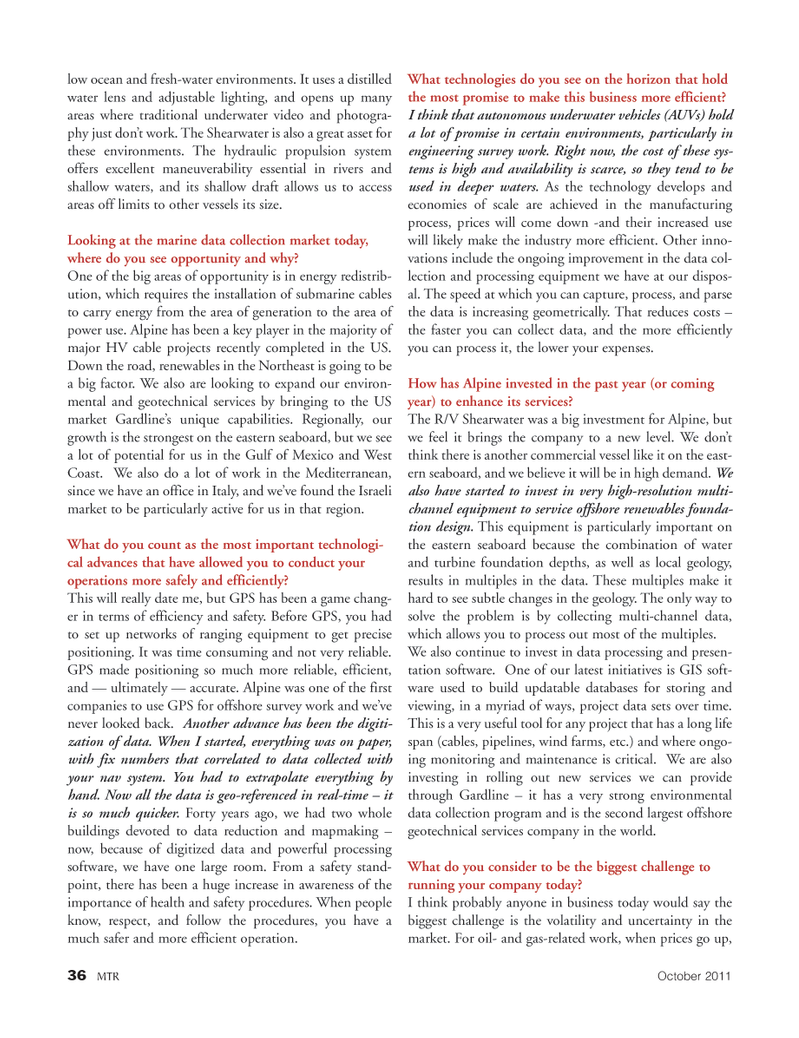
Page 36: of Marine Technology Magazine (October 2011)
Ocean Engineering & Design
Read this page in Pdf, Flash or Html5 edition of October 2011 Marine Technology Magazine
36MTROctober2011 low ocean and fresh-water environments. It uses a distilled water lens and adjustable lighting, and opens up manyareas where traditional underwater video and photogra- phy just don?t work. The Shearwater is also a great asset for these environments. The hydraulic propulsion system offers excellent maneuverability essential in rivers and shallow waters, and its shallow draft allows us to access areas off limits to other vessels its size. Looking at the marine data collection market today, where do you see opportunity and why? One of the big areas of opportunity is in energy redistrib- ution, which requires the installation of submarine cables to carry energy from the area of generation to the area of power use. Alpine has been a key player in the majority of major HV cable projects recently completed in the US. Down the road, renewables in the Northeast is going to be a big factor. We also are looking to expand our environ- mental and geotechnical services by bringing to the US market Gardline?s unique capabilities. Regionally, our growth is the strongest on the eastern seaboard, but we see a lot of potential for us in the Gulf of Mexico and West Coast. We also do a lot of work in the Mediterranean, since we have an office in Italy, and we?ve found the Israeli market to be particularly active for us in that region. What do you count as the most important technologi- cal advances that have allowed you to conduct your operations more safely and efficiently? This will really date me, but GPS has been a game chang- er in terms of efficiency and safety. Before GPS, you had to set up networks of ranging equipment to get precise positioning. It was time consuming and not very reliable. GPS made positioning so much more reliable, efficient, and ? ultimately ? accurate. Alpine was one of the firstcompanies to use GPS for offshore survey work and we?ve never looked back. Another advance has been the digiti- zation of data. When I started, everything was on paper, with fix numbers that correlated to data collected with your nav system. You had to extrapolate everything by hand. Now all the data is geo-referenced in real-time ? it is so much quicker. Forty years ago, we had two whole buildings devoted to data reduction and mapmaking ? now, because of digitized data and powerful processing software, we have one large room. From a safety stand- point, there has been a huge increase in awareness of the importance of health and safety procedures. When people know, respect, and follow the procedures, you have a much safer and more efficient operation. What technologies do you see on the horizon that hold the most promise to make this business more efficient? I think that autonomous underwater vehicles (AUVs) hold a lot of promise in certain environments, particularly in engineering survey work. Right now, the cost of these sys- tems is high and availability is scarce, so they tend to be used in deeper waters. As the technology develops and economies of scale are achieved in the manufacturing process, prices will come down -and their increased use will likely make the industry more efficient. Other inno- vations include the ongoing improvement in the data col- lection and processing equipment we have at our dispos- al. The speed at which you can capture, process, and parse the data is increasing geometrically. That reduces costs ? the faster you can collect data, and the more efficiently you can process it, the lower your expenses. How has Alpine invested in the past year (or coming year) to enhance its services? The R/V Shearwater was a big investment for Alpine, but we feel it brings the company to a new level. We don?t think there is another commercial vessel like it on the east- ern seaboard, and we believe it will be in high demand. Wealso have started to invest in very high-resolution multi- channel equipment to service offshore renewables founda- tion design.This equipment is particularly important on the eastern seaboard because the combination of water and turbine foundation depths, as well as local geology, results in multiples in the data. These multiples make it hard to see subtle changes in the geology. The only way to solve the problem is by collecting multi-channel data, which allows you to process out most of the multiples. We also continue to invest in data processing and presen- tation software. One of our latest initiatives is GIS soft- ware used to build updatable databases for storing and viewing, in a myriad of ways, project data sets over time. This is a very useful tool for any project that has a long life span (cables, pipelines, wind farms, etc.) and where ongo- ing monitoring and maintenance is critical. We are also investing in rolling out new services we can provide through Gardline ? it has a very strong environmental data collection program and is the second largest offshore geotechnical services company in the world. What do you consider to be the biggest challenge to running your company today? I think probably anyone in business today would say the biggest challenge is the volatility and uncertainty in the market. For oil- and gas-related work, when prices go up, MTR#8 (34-49):MTR Layouts 10/10/2011 11:29 AM Page 36

 35
35

 37
37
